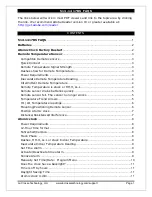
La Crosse Technology, Ltd. www.lacrossetechnology.com/support
Page 4
Inaccurate Remote Temperature Reading
Explanation:
High remote temperature readings are generally a location issue.
Low remote temperature readings are power related or a sensors going bad.
•
The remote sensor reads the environment where it is mounted. When
mounted inside the home, it will read inside temperature.
•
When the remote sensor reads high during the day, but not at night, it is a
positioning
problem.
•
Look for heat sources such as sunlight, door or window frames or reflected
heat.
Side-by-side test:
Place the remote sensor right next to the atomic clock for 2
hours.
•
Compare indoor and remote temperature. The temperatures should be within
4 degrees to be within tolerance.
•
If the remote sensor reads correctly when next to the atomic clock, try a
different location outside.
Intermittent Remote Temperature
Explanation:
Intermittent problems are the hardest to resolve. RF (radio
frequency) communication may come and go occasionally. This can be normal in
some environments (e.g. moister climates). If remote sensor signal is lost, please
wait 2-4 hours for the signal to reconnect on its own.
•
Move the remote sensor to a closer location.
•
can cause loss of remote sensor signal.
•
Check
Freezer test:
Confirm the atomic clock is reading the correct remote sensor (not a
neighbor’s sensor). Place the remote sensor in the freezer for an hour and watch
the temperature drop on the atomic clock.
Indoor distance test:
Please complete the
with remote sensor and atomic
clock 5-10 feet apart and inside to establish a strong connection.
•
After 15 minutes, if there is a reading in the remote temperature area, move
the remote sensor to another room with one wall between the remote sensor
and the atomic clock.
•
Observe to see if the temperature remains on consistently for 1 hour.
•
If the temperature remains on while in the house, then it is likely a
issue.
•
Move the remote sensor to different locations outside to find a location where
the temperature reading will hold.
Remote Temperature is stuck or HH.H, LL.L
Explanation:
These symbols are error messages indicating the remote sensor is
outside of its readable range.












